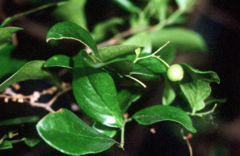Vaccinium arboreum: Difference between revisions
No edit summary |
No edit summary |
||
| (2 intermediate revisions by 2 users not shown) | |||
| Line 1: | Line 1: | ||
{{ | {{SPlantbox | ||
| | |familia=Ericaceae | ||
| | |genus=Vaccinium | ||
| | |species=arboreum | ||
| | |common_name=Farkleberry, Sparkle-Berry | ||
| | |habit=shrub | ||
| | |Min ht box=3 | ||
| | |Min ht metric=m | ||
| | |Max ht box=9 | ||
| | |Max ht metric=m | ||
| | |origin=SE USA | ||
| | |lifespan=perennial | ||
| | |Temp Metric=°F | ||
| | |image=Vaccinium arboreum USDA.jpg | ||
| | |image_width=240 | ||
|image_caption=Leaves and immature fruit | |||
}} | }} | ||
{{Inc| | |||
Vaccinium arboreum, Marsh. Farkleberry. Sparkle-Berry. Spreading shrub or small tree, 6-25 ft. high, with glabrous or somewhat pubescent branchlets: lvs. 1-2 in. long, evergreen in the S., somewhat coriaceous, smooth and shining above, paler and sometimes pubescent beneath, obovate to oval, acute or obtuse, entire or obscurely denticulate: fls. profuse, axillary, and leafy-racemose, pendulous, articulated with the slender pedicel; corolla open-campanulate, 5-lobed, white; stamens included: berry small, globose, black, rather astringent, inedible. Sandy soil along river banks, Fla. and Texas to N. C. and Ill.—"It forms an irregular shrub too diffuse and straggling to be of use except in masses, for which purpose it is useful at the South." | |||
}} | |||
==Cultivation== | |||
{{edit-cult}}<!--- Type cultivation info below this line, then delete this entire line --> | |||
===Propagation=== | |||
{{edit-prop}}<!--- Type propagation info below this line, then delete this entire line --> | |||
===Pests and diseases=== | |||
{{edit-pests}}<!--- Type pest/disease info below this line, then delete this entire line --> | |||
==Species== | |||
<!-- This section should be renamed Cultivars if it appears on a page for a species (rather than genus), or perhaps Varieties if there is a mix of cultivars, species, hybrids, etc --> | |||
<!-- Usually in list format like this: --> | |||
<!-- *''[[Freesia alba]]'' --> | |||
<!-- *''[[Freesia laxa]]'' (syn. ''Anomatheca laxa'', ''Lapeirousia laxa'') --> | |||
==Gallery== | |||
{{photo-sources}}<!-- remove this line if there are already 3 or more photos in the gallery --> | |||
<gallery> | |||
Image:Upload.png| photo 1 | |||
Image:Upload.png| photo 2 | |||
Image:Upload.png| photo 3 | |||
</gallery> | |||
==References== | ==References== | ||
* | <!--- xxxxx *Flora: The Gardener's Bible, by Sean Hogan. Global Book Publishing, 2003. ISBN 0881925381 --> | ||
* | <!--- xxxxx *American Horticultural Society: A-Z Encyclopedia of Garden Plants, by Christopher Brickell, Judith D. Zuk. 1996. ISBN 0789419432 --> | ||
* | <!--- xxxxx *Sunset National Garden Book. Sunset Books, Inc., 1997. ISBN 0376038608 --> | ||
==External links== | |||
*{{wplink}} | |||
{{ | |||
{{stub}} | |||
__NOTOC__ | |||
Latest revision as of 17:24, 13 October 2009
| Vaccinium arboreum subsp. var. | Farkleberry, Sparkle-Berry | |||||||||||||||||||||||||||||||||||||||||||||||||||||||
|---|---|---|---|---|---|---|---|---|---|---|---|---|---|---|---|---|---|---|---|---|---|---|---|---|---|---|---|---|---|---|---|---|---|---|---|---|---|---|---|---|---|---|---|---|---|---|---|---|---|---|---|---|---|---|---|---|

|
|
| ||||||||||||||||||||||||||||||||||||||||||||||||||||||
| ||||||||||||||||||||||||||||||||||||||||||||||||||||||||
| Standard Cyclopedia of Horticulture |
|---|
|
Vaccinium arboreum, Marsh. Farkleberry. Sparkle-Berry. Spreading shrub or small tree, 6-25 ft. high, with glabrous or somewhat pubescent branchlets: lvs. 1-2 in. long, evergreen in the S., somewhat coriaceous, smooth and shining above, paler and sometimes pubescent beneath, obovate to oval, acute or obtuse, entire or obscurely denticulate: fls. profuse, axillary, and leafy-racemose, pendulous, articulated with the slender pedicel; corolla open-campanulate, 5-lobed, white; stamens included: berry small, globose, black, rather astringent, inedible. Sandy soil along river banks, Fla. and Texas to N. C. and Ill.—"It forms an irregular shrub too diffuse and straggling to be of use except in masses, for which purpose it is useful at the South."
|
Cultivation
- Do you have cultivation info on this plant? Edit this section!
Propagation
- Do you have propagation info on this plant? Edit this section!
Pests and diseases
- Do you have pest and disease info on this plant? Edit this section!
Species
Gallery
If you have a photo of this plant, please upload it! Plus, there may be other photos available for you to add.
-
photo 1
-
photo 2
-
photo 3
References
External links
- w:Vaccinium arboreum. Some of the material on this page may be from Wikipedia, under the Creative Commons license.
- Vaccinium arboreum QR Code (Size 50, 100, 200, 500)
